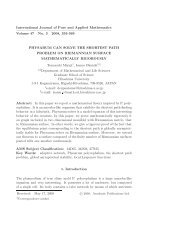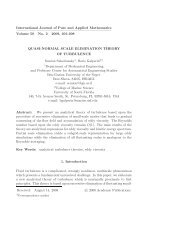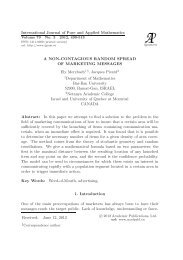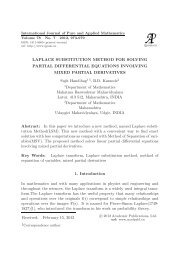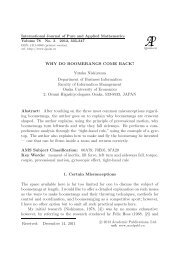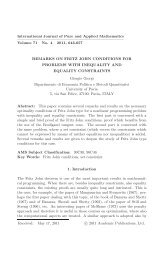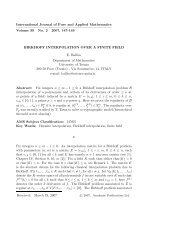SOLVING INVERSE PROBLEMS FOR THE HAMMERSTEIN ...
SOLVING INVERSE PROBLEMS FOR THE HAMMERSTEIN ...
SOLVING INVERSE PROBLEMS FOR THE HAMMERSTEIN ...
Create successful ePaper yourself
Turn your PDF publications into a flip-book with our unique Google optimized e-Paper software.
International Journal of Pure and Applied Mathematics<br />
————————————————————————–<br />
Volume 60 No. 4 2010, 393-408<br />
<strong>SOLVING</strong> <strong>INVERSE</strong> <strong>PROBLEMS</strong> <strong>FOR</strong> <strong>THE</strong> <strong>HAMMERSTEIN</strong><br />
INTEGRAL EQUATION AND ITS RANDOM ANALOG<br />
USING <strong>THE</strong> “COLLAGE METHOD” <strong>FOR</strong> FIXED POINTS<br />
H.E. Kunze 1 § , D. La Torre 2 , K.M. Levere 3 , E.R. Vrscay 4<br />
1,3 Department of Mathematics and Statistics<br />
College of Physical and Engineering Science<br />
University of Guelph<br />
50, Stone Road East, Guelph, Ontario, N1G 2W1, CANADA<br />
1 e-mail: hkunze@uoguelph.ca<br />
3 e-mail: klevere@uoguelph.ca<br />
2 Department of Economics, Business and Statistics<br />
University of Milan<br />
Milan, ITALY<br />
e-mail: davide.latorre@unimi.it<br />
4 Department of Applied Mathematics<br />
University of Waterloo<br />
Waterloo, Ontario, N2L 3G1, CANADA<br />
e-mail: ervrscay@math.uwaterloo.ca<br />
Abstract: Many inverse problems in applied mathematics can be formulated<br />
as the approximation of a target element u in a complete metric space (X,dX)<br />
by the fixed point ¯x of an appropriate contraction mapping T : X ↦→ X. The<br />
method of collage coding seeks to solve this problem by finding a contraction<br />
mapping T that minimizes the so-called collage distance d(x,Tx). In this paper,<br />
we develop a collage coding framework for inverse problems involving deterministic<br />
or random Hammerstein integral operators. Such operators are used to<br />
model image blurring. We illustrate the method with examples.<br />
AMS Subject Classification: 45Q05, 45R05, 60H25<br />
Key Words: Hammerstein integral equations, inverse problems, fixed point<br />
equations, random fixed point equations, collage theorem<br />
Received: March 6, 2010 c○ 2010 Academic Publications<br />
§ Correspondence author
394 H.E. Kunze, D. La Torre, K.M. Levere, E.R. Vrscay<br />
1. Introduction<br />
In this paper, we examine the Hammerstein integral equation in the context of<br />
Banach’s celebrated contraction mapping theorem. The Hammerstein integral<br />
operator is<br />
(Tu)(x) =<br />
� 1<br />
0<br />
K(x,y,u(y))dy + l(x).<br />
In imaging applications, u represents an input signal (or image) and the kernel<br />
K describes how this signal has been blurred. Of course, the kernel can take<br />
on many forms, as an image might be blurred for a wide variety of reasons<br />
ranging from effects of motion capture to focus problems to diffraction effects<br />
of the medium in which a photograph was taken. The term l(x) represents the<br />
contribution of additive noise to the recorded image. The result of applying the<br />
Hammerstein integral operator, Tu, is a blurred and noised image.<br />
Normally, Banach’s Theorem is used to establish the existence and uniqueness<br />
of solutions to the related fixed point equation u = Tu. Our objective,<br />
however, is to show that it can be used to solve the associated inverse problem:<br />
given a recorded signal as well as l, denoise and deblur the image by<br />
recovering the parameters in K (and possibly its functional form).<br />
We also show that the random Hammerstein integral and its related inverse<br />
problem can be treated with a random version of Banach’s Theorem.<br />
As we have shown in previous works by Forte and Vrscay [7], [8], La Torre<br />
and Iacus [9], [10], and Kunze et al [12], [13], [14], [16], [17], a number of inverse<br />
problems in applied mathematics can be formulated as the approximation of<br />
a target element x in a complete metric space (X,dX) by the fixed point ¯x of<br />
an appropriate contraction mapping T : X ↦→ X. In practice, one considers a<br />
family of such contraction mappings Tλ, λ ∈ R n , with respective fixed points<br />
¯xλ, and seeks to minimize the approximation error � x − ¯xλ �. However, it is<br />
generally impractical to search directly for contraction maps Tλ that minimize<br />
this approximation error. Instead, we resort to the following simple consequence<br />
of Banach’s Fixed Point Theorem, referred to as the collage theorem in fractal<br />
imaging literature (see Barsley et al [3]):<br />
dX(x, ¯x) ≤ 1<br />
1 − c dX(x,Tx), for all x ∈ X, (1)<br />
where c is the contraction factor of T. One now seeks a contraction mapping<br />
Tλ that minimizes the so-called collage error dX(x,Tx). In other words, we<br />
look for a contraction mapping T that sends the target x as close as possible<br />
to itself. This is the essence of collage coding that has provided the basis of
<strong>SOLVING</strong> <strong>INVERSE</strong> <strong>PROBLEMS</strong> <strong>FOR</strong> <strong>THE</strong> <strong>HAMMERSTEIN</strong>... 395<br />
most, if not all, fractal image coding and compression methods (see Fischer [6],<br />
Forte and Vrscay [7], [8], and Lu [18]). Indeed, many problems in the parameter<br />
estimation literature (see, for example, Anderson [1] and Milstein [19]) can be<br />
formulated in such a collage coding framework [17], [14], [13], [12].<br />
The structure of the paper is as follows. In Section 2, we state some relevant<br />
mathematical results regarding contraction mappings and their fixed points,<br />
and the inverse problem of approximation by such fixed points. In Sections<br />
3 and 4, we examine Hammerstein-type integral equations and also present a<br />
collage coding method to solve inverse problems. After discussing the deterministic<br />
case in these two sections, we present a parallel discussion in Sections<br />
4-6, ending in the latter section with examples of the solution of the inverse<br />
problem for the random Hammerstein integral equation via the collage theorem<br />
for random fixed point equations.<br />
2. Fixed Point Equations and the “Collage Theorem”<br />
For the benefit of the reader, we mention some important mathematical results.<br />
Definition 1. Let (X,dX) be a metric space. A mapping T : X ↦→ X is<br />
said to be Lipschitz on X if there exists a positive constant K > 0 such that<br />
dX(Tx,Ty) ≤ KdX(x,y), (2)<br />
for all x,y ∈ X. If the inequality is satisfied for K < 1, then T is said to be<br />
contractive. In this case we define its contraction factor c to be the infimum of<br />
all K values.<br />
Theorem 2.1. (Banach Fixed Point Theorem) Let (X,dX) be a complete<br />
metric space. Also let T : X ↦→ X be contractive. Then there exists a unique<br />
¯x ∈ X such that ¯x = T ¯x. Moreover, for any x ∈ X, dX(T n x, ¯x) ↦→ 0 as n ↦→ ∞.<br />
A simple triangle inequality argument along with Banach’s Theorem yields<br />
the following result.<br />
Theorem 2.2. (“Collage Theorem”, see Barnsley et al [2], [3]) Let (X,dX)<br />
be a complete metric space and T : X ↦→ X a contraction mapping with<br />
contraction factor c ∈ [0,1). Then for any x ∈ X,<br />
dX(x, ¯x) ≤ 1<br />
1 − c dX(x,Tx), (3)<br />
where ¯x is the fixed point of T.<br />
Theorem 2.3. (Continuity of Fixed Points, see Centore and Vrscay [5])
396 H.E. Kunze, D. La Torre, K.M. Levere, E.R. Vrscay<br />
Let (X,dX) be a complete metric space and T1,T2 be two contractive mappings<br />
with fixed points ¯x1 and ¯x2. Then<br />
1<br />
dX(¯x1, ¯x2) ≤<br />
1 − min{c1,c2} dsup(T1,T2), (4)<br />
where<br />
dsup(T1,T2) = sup dX(T1(x),T2(x)) (5)<br />
x∈X<br />
and ci is the contractivity factor of Ti.<br />
Another manipulation of the triangle inequality involving x, Tx and ¯x yields<br />
the following interesting result.<br />
Theorem 2.4. (“Anti-Collage Theorem”, see Vrscay and Saupe [20])<br />
Assume the conditions of the collage theorem above. Then for any x ∈ X,<br />
dX(x, ¯x) ≥ 1<br />
1 + c dX(x,Tx). (6)<br />
3. The Hammerstein Integral Equation<br />
We are now interested in finding solutions of the fixed point equation u = Tu<br />
where T is a Hammerstein integral operator having the form<br />
(Tu)(x) =<br />
� 1<br />
0<br />
K(x,y,u(y))dy + l(x). (7)<br />
Here, l : [0,1] ↦→ R is a given function and K : R × R × R ↦→ R satisfies<br />
|K(α1,β,γ) − K(α2,β,γ)| ≤ C1(β,γ)|α1 − α2| (8)<br />
and |K(α,β,γ1) − K(α,β,γ2)| ≤ C2(α,β)|γ1 − γ2|. (9)<br />
Furthermore suppose that for u ∈ L 2 ([0,1]) the function ξ(y) := C1(y,u(y))<br />
belongs to L 2 ([0,1]). These next results are quite simple, and we mention them<br />
for the benefit of the reader. The first result states the existence and uniqueness<br />
of the solution in the space C([0,1]).<br />
Theorem 3.1. Let l : [0,1] ↦→ R be a continuous function, then:<br />
(i) (Tu)(x) is a continuous function.<br />
(ii) if �C2�∞ := sup α,β∈[0,1] |C2(α,β)| < 1 then T : C([0,1]) ↦→ C([0,1]) is a<br />
contraction.
<strong>SOLVING</strong> <strong>INVERSE</strong> <strong>PROBLEMS</strong> <strong>FOR</strong> <strong>THE</strong> <strong>HAMMERSTEIN</strong>... 397<br />
Proof. Given a continuous function u ∈ C([0,1]), we have<br />
|(Tu)(x) − (Tu)(z)| ≤<br />
� 1<br />
0<br />
≤ |x − z|<br />
≤ |x − z|<br />
|K(x,y,u(y)) − K(z,y,u(y))|dy + |l(x) − l(z)|<br />
� 1<br />
0<br />
�� 1<br />
0<br />
|C1(y,u(y))|dy + |l(x) − l(z)|<br />
|C1(y,u(y))| 2 �<br />
dy<br />
1<br />
2<br />
+ |l(x) − l(z)| (10)<br />
and this shows the continuity of the function (Tu)(x). To prove contractivity<br />
we have<br />
d∞(Tu,Tv) = sup<br />
≤ sup<br />
x∈[0,1]<br />
� 1<br />
0<br />
x∈[0,1]<br />
|(Tu)(x) − (Tv)(x)|<br />
|K(x,y,u(y))−K(x,y,v(y))|dy ≤ sup<br />
x∈[0,1]<br />
� 1<br />
Consider now the operator T on the space L 2 ([0,1]).<br />
0<br />
|C2(x,y)||u(y)−v(y)|dy<br />
≤ �C2�∞d∞(u,v). �<br />
Theorem 3.2. Suppose l ∈ C([0,1]) and C2 ∈ L 2 ([0,1] × [0,1]) with<br />
�C2�2 < 1. Then T : L 2 ([0,1]) ↦→ L 2 ([0,1]) is a contraction.<br />
Proof. We first prove that Tu ∈ L2 ([0,1]). For each fixed x1,x2 ∈ [0,1], we<br />
compute<br />
|Tu(x1) − Tu(x2)| ≤<br />
� 1<br />
0<br />
≤ |x1 − x2|<br />
≤ |x1 − x2|<br />
|K(x1,y,u(y)) − K(x2,y,u(y))|dy + |l(x1) − l(x2)|<br />
� 1<br />
0<br />
�� 1<br />
0<br />
|C1(y,u(y))|dy + |l(x1) − l(x2)|<br />
|C1(y,u(y))| 2 �<br />
dy<br />
1<br />
2<br />
+ |l(x1) − l(x2)|.<br />
So the function (Tu)(x) is bounded on [0,1] and then it belongs to L2 ([0,1]).<br />
To prove contractivity we have<br />
�Tu − Tv� 2 2 =<br />
≤<br />
� 1<br />
0<br />
�<br />
�<br />
�<br />
�<br />
� 1<br />
0<br />
≤<br />
� 1<br />
0<br />
|(Tu)(x) − (Tv)(x)| 2 dx<br />
K(x,y,u(y))dy + l(x) −<br />
� 1 �� 1<br />
0<br />
0<br />
� 1<br />
0<br />
�<br />
�<br />
K(x,y,v(y))dy − l(x) �<br />
�<br />
|K(x,y,u(y)) − K(x,y,v(y))|dy<br />
�2<br />
dx<br />
2<br />
dx
398 H.E. Kunze, D. La Torre, K.M. Levere, E.R. Vrscay<br />
≤<br />
� 1 �� 1<br />
0<br />
0<br />
|C2(x,y)||u(y) − v(y)|dy<br />
≤<br />
� 1<br />
0<br />
�2<br />
dx<br />
�C2� 2 2�u − v�22 dx = �C2� 2 2�u − v�22 . �<br />
Corollary 3.1. If C2 ∈ L 2 ([0,1] × [0,1]) and �C2�2 < 1 then the fixed<br />
point equation Tu = u has a unique solution ū belonging to L 2 ([0,1]) and for<br />
all u0 ∈ L 2 ([0,1]) the sequence un = Tun−1 converges to ū. If �C2�∞ < 1 then<br />
ū is continuous.<br />
4. Inverse Problem for the Hammerstein Integral Equation<br />
For each fixed u ∈ R we have K(x,y, ·) ∈ L2 ([0,1] × [0,1]), and then<br />
∞�<br />
K(x,y,u) = ai,j(u)φj(x)φi(y), (11)<br />
i,j=1<br />
where φi(y) is an orthonormal basis in L 2 ([0,1]). For u ∈ C([0,1]), we suppose<br />
that the functions ai,j(u) satisfy:<br />
(i) ai,j(u) ∈ L2 ([umin,umax]) where umin = min<br />
0≤x≤1 u(x) and umax = max<br />
0≤x≤1 u(x),<br />
so that<br />
∞�<br />
ai,j(u) = ai,j,kψk(u),<br />
k=1<br />
where ψk(u) is a basis for L2 ([umin,umax]).<br />
�<br />
� ∞�<br />
�<br />
�<br />
�<br />
�<br />
(ii) Let |ai,j(u) − ai,j(v)| = � ai,j,k(ψk(u) − ψk(v)) �<br />
�<br />
�<br />
k=1<br />
≤ bi,j|u − v|. Then<br />
�<br />
�<br />
�<br />
�<br />
��<br />
�<br />
|K(x,y,u) − K(x,y,v)| = �<br />
� (ai,j(u) − ai,j(v))φj(x)φi(y) �<br />
�<br />
� i,j<br />
�<br />
�<br />
�<br />
�<br />
��<br />
�<br />
�<br />
≤ �<br />
� bi,jφj(x)φi(y) �<br />
� |u − v|,<br />
� i,j �<br />
�<br />
�<br />
�<br />
��<br />
�<br />
�<br />
so C2(x,y) = �<br />
� bi,jφj(x)φi(y) �<br />
� in (9).<br />
�<br />
�<br />
i,j<br />
We truncate each sum at upper limit n. Given a target solution u ∈ C([0,1])
<strong>SOLVING</strong> <strong>INVERSE</strong> <strong>PROBLEMS</strong> <strong>FOR</strong> <strong>THE</strong> <strong>HAMMERSTEIN</strong>... 399<br />
and the function l(x), the inverse problem consists of finding coefficients ai,j,k<br />
in the expansion of K so that u is approximately admitted as the fixed point<br />
of the corresponding Hammerstein integral operator. Our collage distance is<br />
�u − Tu� 2 2 =<br />
� � 1 � �<br />
� 1<br />
2<br />
�<br />
�<br />
�u(x) − K(x,y,u(y))dy − l(x) �<br />
� dx<br />
0 0<br />
�<br />
� � 1 �<br />
= �<br />
�<br />
0 � −<br />
�<br />
n�<br />
n�<br />
� 1 n�<br />
�2<br />
�<br />
ujφj(x) + ljφj(x) + ai,j,kψk(u(y))φi(y)φj(x)dy �<br />
� dx<br />
j=1 j=1<br />
0<br />
i,j,k=1<br />
�<br />
� ⎛<br />
⎞�<br />
� � 1 � n�<br />
n�<br />
� 1 n�<br />
�2<br />
�<br />
= �<br />
� φj(x) ⎝−uj + lj + ai,j,k ck,lφl(y)φi(y)dy ⎠�<br />
� dx<br />
0 �j=1<br />
i,k=1<br />
0<br />
l=1<br />
�<br />
� ⎛<br />
⎞�<br />
� � 1 � n�<br />
n�<br />
�2<br />
�<br />
= �<br />
� φj(x) ⎝−uj + lj + ai,j,kck,l⎠�<br />
� dx<br />
0 �j=1<br />
i,k,l=1 �<br />
⎡<br />
� 1 n�<br />
≤ ⎣ φ 2 ⎤ ⎡ ⎛<br />
⎞2⎤<br />
n�<br />
n�<br />
j(x) ⎦ ⎣ ⎝−uj + lj + ⎠ ⎦ dx<br />
0<br />
⎡<br />
= ⎣<br />
� 1<br />
0<br />
j=1<br />
j=1<br />
j=1<br />
n�<br />
φ 2 ⎤ ⎡ ⎛<br />
n�<br />
j(x)dx⎦<br />
⎣ ⎝−uj + lj +<br />
j=1<br />
= n<br />
i,k,l=1<br />
ai,j,kck,l<br />
n�<br />
i,k,l=1<br />
⎛<br />
n�<br />
⎝−uj + lj +<br />
j=1<br />
ai,j,kck,l<br />
n�<br />
i,k,l=1<br />
⎞2⎤<br />
⎠<br />
⎦<br />
ai,j,kck,l<br />
where ck,l = ck,l(u1,...,un) have known values since ψk are chosen and u = u(y)<br />
is our known target function. Regarding the constraints we have that:<br />
� 1 � 1<br />
(C2(x,y)) 2 ⎛<br />
� 1 � 1<br />
dxdy = ⎝ �<br />
⎞2<br />
bi,jφj(x)φi(y) ⎠ dxdy<br />
0<br />
0<br />
=<br />
0 0<br />
� 1 � 1<br />
0<br />
+2<br />
= �<br />
i,j<br />
0 i,j<br />
� 1 � 1<br />
0<br />
b 2 i,j<br />
i,j<br />
�<br />
(bi,jφj(x)φi(y)) 2 dxdy<br />
0<br />
�<br />
i,j,h,k<br />
� 1<br />
+ 2 �<br />
i,j,h,k<br />
φj(x)φi(y)φh(x)φk(y)dxdy<br />
0<br />
φj(x)φh(x)dx<br />
� 1<br />
0<br />
⎞<br />
⎠<br />
2<br />
φi(y)φk(y)dy<br />
,
400 H.E. Kunze, D. La Torre, K.M. Levere, E.R. Vrscay<br />
= �<br />
b 2 i,j .<br />
So now the inverse problem becomes:<br />
i,j<br />
min �u − Tu�<br />
A 2 , (12)<br />
where A = { �<br />
i,j b2i,j ≤ CA < 1}.<br />
Example. We set l(x) = x and set Ktrue(x,y,u) = ktrue(x,y)u. In this<br />
case, ai,j(u) = ai,ju, so that<br />
∞�<br />
Ktrue(x,y,u) = ai,jφj(x)φi(y),<br />
�u − Tu� 2 2 ≤<br />
and bi,j = ai,j. We define<br />
Let<br />
⎧<br />
⎪⎨<br />
ktrue(x,y) =<br />
⎪⎩<br />
i,j=1<br />
n�<br />
�<br />
−uj + lj +<br />
i=1<br />
φ(·) ∈ {φs(·),φc(·)} =<br />
n�<br />
i=0<br />
ai,juj<br />
� 2<br />
π(−1 − x + y), x − y < − 1<br />
2 ,<br />
π(x − y), − 1 1<br />
≤ x − y ≤<br />
2 2 ,<br />
1<br />
π(1 − x + y), < x − y ≤,<br />
2<br />
�√ √ �<br />
2 sin(π·), 2 cos(π·) . (13)<br />
In this rather limited finite basis, the representation of ktrue(x,y) is<br />
kbasis(x,y) = 2<br />
π φs(x)φc(y) − 2<br />
π φc(x)φs(y) = 4<br />
sin(π(x − y)).<br />
π<br />
We build the Hammerstein integral operator<br />
(Ttrueu) (x) =<br />
� 1<br />
0<br />
ktrue(x,y)u(y)dy + l(x),<br />
and construct an approximation of its fixed point ūtrue(x) by iterating the map<br />
20 times on the initial function u0(x) = 0. We set utarget(x) = T 20u0(x). See<br />
Figure 1. Thus, our example inverse problem is: Given utarget(x) and l(x), find<br />
a representation of the kernel k(x,y) in our finite basis such that the corresponding<br />
Hammerstein integral operator admits utarget(x) as an approximate<br />
solution. Following our development, we minimize the constrained squared L2 collage distance<br />
∆ 2 = �u − Tu� 2 ⎛<br />
2 + λ⎝<br />
�<br />
⎞<br />
− CA⎠,<br />
i,j<br />
a 2 i,j<br />
,
<strong>SOLVING</strong> <strong>INVERSE</strong> <strong>PROBLEMS</strong> <strong>FOR</strong> <strong>THE</strong> <strong>HAMMERSTEIN</strong>... 401<br />
Figure 1: The graph of z = ktrue(x,y), z = kbasis(x,y), and y =<br />
utarget(x)<br />
where CA ∈ (0,1) is a chosen fixed value. We denote the kernel that minimizes<br />
∆ 2 by kcollage(x,y), and we observe that the desired result is kcollage(x,y) =<br />
kbasis(x,y). To achieve this result, we would have to set<br />
CA = 2<br />
� 2<br />
π<br />
� 2<br />
≈ 0.81057.<br />
Instead, we systematically set CA = i<br />
10 , i = 1,2,... ,9, and minimize each<br />
corresponding ∆2 . Perhaps, one might anticipate that the minimum of the<br />
nine minimal collage distances we find will occur when CA = 0.8.<br />
In Table 1, we present the results obtained when we restrict our basis fur-
402 H.E. Kunze, D. La Torre, K.M. Levere, E.R. Vrscay<br />
ther, so that it consists of precisely the two functions ψ1(x,y) = 2sin(πx)cos(πy)<br />
and ψ2(x,y) = 2cos(πx)sin(πy), which appear in ktrue(x,y). The pleasing re-<br />
CA minimal ∆ 2 a1 a2<br />
0.1 0.17153 0.29898 −0.10301<br />
0.2 0.12759 0.40955 −0.17964<br />
0.3 0.09614 0.48283 −0.25860<br />
0.4 0.07136 0.53421 −0.33856<br />
0.5 0.05088 0.57113 −0.41690<br />
0.6 0.03356 0.59838 −0.49187<br />
0.7 0.01929 0.61908 −0.56280<br />
0.8 0.01120 0.63526 −0.62964<br />
0.9 0.01613 0.64823 −0.69267<br />
Table 1: Collage coding results with kcollage(x,y) = a1φ1(x,y) +<br />
a2φ2(x,y) and a2 1 + a22 = CA<br />
sult is that the minimum of the minimal collage distances occurs when CA = 0.8.<br />
Indeed,<br />
a1 and − a2 ≈ 2<br />
≈ 0.63661,<br />
π<br />
the true best result.<br />
Note that when we minimize ∆ 2 , treating CA as an additional variable, we<br />
obtain λ = 0, a linear system in the coefficients a1 and a2, and a constraint<br />
equation, as opposed to an inequality. Still, upon solving the linear system for<br />
a1 and a2, we can check whether these minimizing values lead to a value of<br />
CA < 1. For this example, we obtain a1 = 0.63644 and a2 = 0.63675, giving<br />
CA = 0.81051.<br />
When we add the basis function φs(2x)φs(y) with coefficient a3, we obtain<br />
a1 = 0.63675, a2 = −0.55321, and a3 = 0.04580, with CA = 0.71359. The<br />
quality of the approximation diminishes in part because in this example �C2�2 =<br />
0.90690, meaning the operator is not very contractive.<br />
If we modify κtrue, replacing each π by π<br />
8 , then the new value of �C2�2 is the<br />
smaller 0.113362. We obtain a1 = 0.07957, a2 = −0.07495, and a3 = 0.00722,<br />
compared to the desired values a1 = −a2 = 1<br />
4π ≈ 0.07958 and a3 = 0.
<strong>SOLVING</strong> <strong>INVERSE</strong> <strong>PROBLEMS</strong> <strong>FOR</strong> <strong>THE</strong> <strong>HAMMERSTEIN</strong>... 403<br />
5. Random Fixed Point Equations and the<br />
“Random Collage Theorem”<br />
Again let (X,dX) denote a complete metric space. If (X,dX) is separable,<br />
then it is said to be a Polish space. We also let (Ω, F,µ) be a probability<br />
space. A mapping T : Ω × X ↦→ X is called a random operator if for any<br />
x ∈ X the function T(·,x) is measurable. The random operator T is said to<br />
be continuous/Lipschitz/contractive if, for a.e. ω ∈ Ω, we have that T(ω, ·) is<br />
continuous/Lipschitz/contractive (see Bharucha and Reid [4]).<br />
A measurable mapping x : Ω ↦→ X is called a random fixed point of the<br />
random operator T if x is a solution of the equation<br />
T(ω,x(ω)) = x(ω), a.e. ω ∈ Ω. (14)<br />
Consider the space Y of all measurable functions x : Ω ↦→ X. If we define the operator<br />
˜ T : Y ↦→ Y as ( ˜ Ty)(ω) = T(ω,x(ω)), then the solutions of this fixed point<br />
equation on Y are the solutions of the random fixed point equation T(ω,x(ω)) =<br />
x(ω). Suppose that the metric dX is bounded, that is, dX(x1,x2) ≤ K for all<br />
x1,x2 ∈ X. Then the function ψ(ω) = dX(x1(ω),x2(ω)) : Ω ↦→ R is an element<br />
of L1 (Ω) for all x1,x2 ∈ Ω. Define the following function over the space Y × Y :<br />
�<br />
dY (x1,x2) = dX(x1(ω),x2(ω))dPω = E(dX(x1,x2)). (15)<br />
Ω<br />
In Kunze et al [15], we proved the following two results.<br />
Theorem 5.1. The space (Y,dY ) is a complete metric space.<br />
Theorem 5.2. Suppose that:<br />
(i) for all x ∈ Y the function ξ : Ω ↦→ X1 defined by ξ(ω) := T(ω,x(ω)),<br />
∀ ω ∈ Ω belongs to Y ,<br />
(ii) dY ( ˜ Tx1, ˜ Tx2) ≤ cdY (x1,x2) with c < 1.<br />
Then there exists a unique solution of ˜ T ¯x = ¯x, that is, T(ω, ¯x(ω)) = ¯x(ω)<br />
for a.e. ω ∈ Ω.<br />
Hypothesis (i) can be avoided if X is a Polish space, in which case the<br />
following result (see Itoh [11]) holds.<br />
Theorem 5.3. Let X be a Polish space, that is, a separable complete<br />
metric space, and T : Ω × X ↦→ X be a mapping such that for each ω ∈ Ω<br />
the function T(ω,.) is c(ω)-Lipschitz and for each x ∈ X the function T(.,x)<br />
is measurable. Let x : Ω ↦→ X be a measurable mapping; then the mapping<br />
ξ : Ω ↦→ X defined by ξ(ω) = T(ω,x(ω)) is measurable.
404 H.E. Kunze, D. La Torre, K.M. Levere, E.R. Vrscay<br />
Corollary 5.1. Let T : Ω × X ↦→ X be a mapping such that for each<br />
ω ∈ Ω the function T(ω,.) is a c(ω)-contraction. Suppose that for each x ∈ X<br />
the function T(.,x) is measurable. Then there exists a unique solution of the<br />
equation ˜ T ¯x = ¯x that is T(ω, ¯x(ω)) = ¯x(ω) for a.e. ω ∈ Ω.<br />
As a consequence of the collage and continuity theorems, we have the following.<br />
Corollary 5.2. Suppose that the hypotheses of Theorem 5.2 are satisfied.<br />
Then for any x ∈ Y ,<br />
1<br />
1 + c dY (x, ˜ Tx) ≤ dY (x, ¯x) ≤ 1<br />
1 − c dY (x, ˜ Tx), (16)<br />
where ¯x is the fixed point of ˜ T, that is, ¯x(ω) := T(ω, ¯x(ω)), ω ∈ Ω.<br />
6. Inverse Problem for the Random Hammerstein Integral Equation<br />
We now consider the case when the kernel K and the function l also depend on<br />
ω ∈ Ω, where (Ω, F,p) is a probability space. Suppose that for a.e. ω ∈ Ω, we<br />
have<br />
P (w : |K(ω,α1,β,γ) − K(ω,α2,β,γ) ≤ C1(β,γ)|α1 − α2|) = 1, (17)<br />
and P (w : |K(ω,α,β,γ1) − K(ω,α,β,γ2) ≤ C2(α,β)|γ1 − γ2|) = 1, (18)<br />
and that for u(y) ∈ L2 ([0,1]) we have C1(u,u(y)) ∈ L2 ([0,1]). Furthermore,<br />
assume that l(ω, ·) ∈ C([0,1]) and that �C2�2 < 1 for a.e. ω ∈ Ω. Then for<br />
a.e. ω ∈ Ω, there is a unique function ū(ω,x) ∈ Ω × L2 ([0,1]) such that<br />
ū(ω,x) = T(ω,x,ū(ω,x)) =<br />
� 1<br />
0<br />
K(ω,x,y,ū(ω,y))dy + l(ω,x). (19)<br />
The inverse problem can be formulated as: Given a function u : Ω ↦→ L 2 ([0,1])<br />
and a family of operators ˜ Tλ : Y ↦→ Y , where Y = {all measurable functions x :<br />
Ω ↦→ X}, find λ such that u is the solution of random fixed point equation<br />
˜Tλu = u, (20)<br />
or, equivalently,<br />
Tλ(ω,ū(ω)) = ū(ω). (21)<br />
Example. Extending our deterministic example, we set l(x,ω) = a(ω)x,<br />
where a(ω) is a random variable with known mean µa and variance σ2 a , and<br />
define<br />
kbasis(x,y) = ksc(ω)φs(x)φc(y) − kcs(ω)φc(x)φs(y),
<strong>SOLVING</strong> <strong>INVERSE</strong> <strong>PROBLEMS</strong> <strong>FOR</strong> <strong>THE</strong> <strong>HAMMERSTEIN</strong>... 405<br />
where ksc(ω) and kcs(ω) are random variables with unknown means µsc and µcs<br />
and variances σ 2 sc and σ 2 cs, respectively. Given data from realizations u(ωj,x),<br />
j = 1,... ,N, of the random variable u(ω,x), the fixed point of the corresponding<br />
T, along with l(x,ω), we wish to recover the means and variances of the<br />
kernel parameters.<br />
Each of the realizations u(ωj,x), j = 1,... ,N, of the random variable<br />
u(ω,x) is the solution of a fixed point equation<br />
u(ωj,x) =<br />
� 1<br />
0<br />
(ksc(ωj)φs(x)φc(y) − kcs(ωj)φc(x)φs(y)) u(ωj,y)dy + a(ωj)x.<br />
Now, for each of our target functions, u(ωj,x), we can find the constant<br />
values ksc(ωj) and kcs(ωj) via the collage coding method for the deterministic<br />
Hammerstein integral equation, as in Section 4. Upon treating each of our<br />
realizations, we will have found values for ksc(ωj) and kcs(ωj) for j = 1,... ,N.<br />
We then construct the approximations<br />
N�<br />
N�<br />
µsc ≈ µsc,N = 1<br />
N<br />
j=1<br />
ksc(ωj) and µcs ≈ µcs,N = 1<br />
N<br />
j=1<br />
kcs(ωj). (22)<br />
Note that the results obtained from collage coding each realization are independent.<br />
Using these approximations of the means, we can also calculate the<br />
variances:<br />
σ 2 sc ≈ σ 2 sc,N =<br />
and σ 2 cs ≈ σ2 cs,N =<br />
1<br />
N − 1<br />
1<br />
N − 1<br />
N�<br />
(ksc(ωj) − µsc,N) 2<br />
j=1<br />
N�<br />
(kcs(ωj) − µcs,N) 2 .<br />
Some results are presented in Table 2. The first three columns present the<br />
distributions of a, ksc, and kcs used to generate the realizations. The final two<br />
columns present the approximations of the means and variances obtained by<br />
our collage method for the various values of N specified in the middle column.<br />
In all cases, we have treated the constraint value CA as a parameter when<br />
minimizing each collage objective function.<br />
Our method correctly identifies the distribution of the random variable and<br />
finds good approximations of the mean and variance. As expected, a larger<br />
sample size produces better estimates of the mean and variance.<br />
j=1
406 H.E. Kunze, D. La Torre, K.M. Levere, E.R. Vrscay<br />
True Values Collage Method Approximations<br />
a ksc kcs N ksc kcs<br />
N(1, 0.01) N (0.6, 0.0004) N (0.6,0.0004) 10 (0.62681,0.00067) (-0.62649,0.00066)<br />
N(1, 0.01)<br />
exp(1)<br />
N (0.6, 0.0004)<br />
exp<br />
N (0.6,0.0004) 100 (0.63655,0.00065) (-0.63613,0.00063)<br />
` ´<br />
π<br />
exp ` ´<br />
π<br />
10 (0.46817,0.41222) (-0.46817,0.41222)<br />
2<br />
exp(1) exp ` ´ π<br />
2<br />
2<br />
exp ` ´ π<br />
2<br />
100 (0.65473,0.42717) (-0.64155,0.37227)<br />
Table 2: Results for the random Hammerstein integral operator inverse<br />
problem, approximations are in the form (mean, variance)<br />
Acknowledgments<br />
This work was developed during a research visit by D. La Torre to the Department<br />
of Applied Mathematics of the University of Waterloo. D. La Torre<br />
thanks ERV for this opportunity. For D. La Torre this work has been supported<br />
by COFIN Research Project 2004. This work has also been supported in part<br />
by research grants (H.E. Kunze and E.R. Vrscay) and a Canadian Graduate<br />
Scholarship (K.M. Levere) from the Natural Sciences and Engineering Research<br />
Council of Canada (NSERC), which are hereby gratefully acknowledged.<br />
References<br />
[1] D. Anderson, Compartmental Modeling and Tracer Kinetics, Springer,<br />
Berlin (1983).<br />
[2] M.F. Barnsley, Fractals Everywhere, Academic Press, New York (1989).<br />
[3] M.F. Barnsley, V. Ervin, D. Hardin, J. Lancaster, Solution of an inverse<br />
problem for fractals and other sets, Proc. Nat. Acad. Sci., USA, 83 (1985),<br />
1975-1977.<br />
[4] A.T. Bharucha-Reid, Random integral equations, Mathematics in Science<br />
and Engineering, Volume 96, Academic Press, New York-London (1972).<br />
[5] P. Centore, E.R. Vrscay, Continuity of fixed points for attractors and invariant<br />
meaures for iterated function systems, Canadian Math. Bull., 37<br />
(1994), 315-329.<br />
[6] Y. Fisher, Fractal Image Compression, Theory and Application, Springer-<br />
Verlag, NY (1995).
<strong>SOLVING</strong> <strong>INVERSE</strong> <strong>PROBLEMS</strong> <strong>FOR</strong> <strong>THE</strong> <strong>HAMMERSTEIN</strong>... 407<br />
[7] B. Forte, E.R. Vrscay, Theory of generalized fractal transforms, Fractal<br />
Image Encoding and Analysis, NATO ASI Series F, Volume 159 (Ed. Y.<br />
Fisher), Springer-Verlag, New York (1998).<br />
[8] B. Forte, E.R. Vrscay, Inverse problem methods for generalized fractal<br />
transforms, Fractal Image Encoding and Analysis, ibid.<br />
[9] S.M. Iacus, D. La Torre, Approximating distribution functions by iterated<br />
function systems, Journal of Applied Mathematics and Decision Sciences,<br />
1 (2005), 334-345.<br />
[10] S.M. Iacus, D. La Torre, A comparative simulation study on the IFS distribution<br />
function estimator, Nonlinear Analysis: Real World Applications,<br />
6 (2005), 774-785.<br />
[11] S. Itoh, Random fixed point theorems with an application to random differential<br />
equations in banach spaces, J. Math. Anal. App., 67 (1979), 261-273.<br />
[12] H. Kunze, D. Crabtree, Using Collage Coding to Solve Inverse Problems in<br />
Partial Differential Equations, Maplesoft Conference Proceedings (2005).<br />
[13] H. Kunze, S. Gomes, Solving an inverse problem for Urison-type integral<br />
equations using Banach’s Fixed Point Theorem, Inverse Problems, 19<br />
(2003), 411-418.<br />
[14] H. Kunze, J. Hicken, E.R. Vrscay, Inverse problems for ODEs using contraction<br />
maps: Suboptimality of the “Collage Method”, Inverse Problems,<br />
20 (2004), 977-991.<br />
[15] H. Kunze, D. La Torre, E.R. Vrscay, Random fixed point equations and<br />
inverse problems by collage method, UNIMI - Research Papers in Economics,<br />
Business and Statistics, www.bepress.edu/unimi.<br />
[16] H. Kunze, S. Murdock, Solving inverse two-point boundary value problems<br />
using collage coding, Inverse Problems, 22 (2006), 1179-1190.<br />
[17] H. Kunze, E.R. Vrscay, Solving inverse problems for ordinary differential<br />
equations using the Picard contraction mapping, Inverse Problems, 15<br />
(1999), 745-770.<br />
[18] N. Lu, Fractal Imaging, Academic Press, NY (2003).
408 H.E. Kunze, D. La Torre, K.M. Levere, E.R. Vrscay<br />
[19] J. Milstein, The inverse problem: Estimation of kinetic parameters, In:<br />
Modeling of Chemical Reaction Systems (Ed-s: K. Ebert, P. Deuflhard,<br />
W. Jäger), Springer, Berlin (1981).<br />
[20] E.R. Vrscay, D. Saupe, Can one break the “collage barrier” in fractal image<br />
coding?, In: Fractals: Theory and Applications in Engineering (Ed-s: M.<br />
Dekking, J. Levy-Vehel, E. Lutton, C. Tricot), Springer-Verlag, London<br />
(1999), 307-323.



